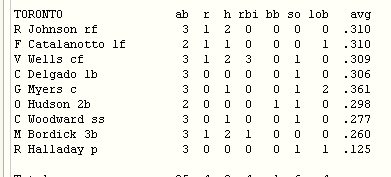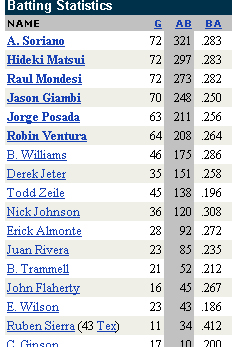As of today, the Toronto Blue Jays are 9 games above 500. That’s a remarkable start.
Baseball is unlike hockey and basketball in this respect: April matters. The Blue Jays could play .500 baseball the rest of the season and still have a good shot at the Wild Card. In fact, last year the Jays did pretty well play .500 most of the season— but they didn’t have a 19-10 start to play with.
Most baseball writers that I have scanned think the Blue Jays are not for real. They point to their relatively easy schedule, and the fact that some players, like Kevin Millar and Marco Scutaro, are performing above their career norms.

Partly true. It is also true that one of the reasons that Baltimore and Detroit and Cleveland and Minnesota are seen as “weaker” opponents is that they were beaten by the Blue Jays, and the Blue Jays do not have a lot of big names in their line-up. Ever heard of Adam Lind? Aaron Hill? Lyle Overbay? Travis Snider? Rob Barajas?
On the other hand… Blue Jays’ pitching has been average, at best. Last year, it was the best pitching staff in the majors. Unfortunately, they lost A. J. Burnett to free agency, and two very promising talents, Shaun Marcum and Dustin McGowan, are injured. On the plus side, rookie Ricky Romero has been impressive– now he’s out with a muscle pull. Jesse Litsch, also on the DL, and Scott Richmond have been solid. Rookie Brett Cecil gave up one earned run in six innings as a fill-in fifth starter. Their relievers have been excellent, but that’s nothing new: no relief corps has been better than the Blue Jays’ over the past three years. The weak spot: B. J. Ryan, who has nothing so far this year. One hopes and prays the Blue Jays don’t waste a month trying to figure out if he is going to get it back– not with Scott Downs pitching the way he has.
I think the Blue Jays have a shot, mainly because their pitching is likely to improve with the return of Romero and Litsch, and possibly Marcum. Tallet will then be available to the bullpen again, which improves that area. Or maybe not. In his past two starts, 13 innings, Tallet has allowed one run.
Yes, Scutaro is not likely to maintain his current pace, and Rolen and Overbay will probably settle into an average average average, and Well’s hasn’t convinced me that he is a real star who can carry the team for a few days once in a while.
But Alex Rios might yet find his stroke.
Barajas has also been knocking the ball silly the past month and that is not likely to continue, but they will get some production out of him.
Aaron Hill is a solid 20 HR .290 hitter. Maybe he has a good year and bits 28 HR, .315.
You know, I don’t see it. I don’t understand why the Blue Jays suddenly lead both leagues in most offensive categories. Where’s it coming from? Not from Wells or Rios or Overbay. But whenever I hear someone say their balloon is about to pop, I look at the team and think– maybe not. In the last few years, it has not been unusual for a team to come out of nowhere and make a run at the World Series. The White Sox. The Rays. Philadelphia. Florida. Anaheim.
As a fan, I have high hopes for a team that is currently performing well. I suspect that they will come down to earth to some extent once they face better teams this month.
Last year, the Blue Jays were .500 against the Yankees and Red Sox. If they do that again this year, and if the Rays and Orioles continue to struggle, there is a real chance the Jays will take at least the Wild Card.
So I’m predicting 94 wins and the wild card. And if they get that, anything’s possible because Halladay remains one of the two or three best money pitchers in the American League right now, and an excellent bullpen, solid defense, and a couple of good hitters can take you a long way in the playoffs.
One more possibility: Adam Lind may be the next great power hitter in the American League. Everyone starts somewhere.
As I write… the Blue Jays are leading the Angels 7-0 after two innings. The devastating offense continues. ..
Almost all of the columnists who feel that the Blue Jays are not for real insist they have had a very easy schedule so far– they haven’t had to face any teams from their own division. Except Baltimore. (Which was picked by some pundits to contend this year.)
Among the other teams they faced: Detroit, Minnesota, Cleveland, Oakland, Texas, and the White Sox. All of these teams except Cleveland and Oakland are at or near .500. Kansas is in first place and is the only team to win a series from the Blue Jays this year. Soft schedule? Maybe. But last year, the Blue Jays finished with an 86-76 record largely because they lost to inferior teams while doing relatively well against the better teams, like Boston and New York (.500 combined).
Managing Middles
Sometimes late in a close game you will see a manager position his infielders so that they are “guarding the line”. Why? Allegedly, to prevent doubles. Well, that’s a good idea, isn’t it? So why not do it all the time?
Think about it. Why not do it all the time, if it’s a good idea?
Because it’s not a good idea. Because everybody knows that you will give up more singles and get less outs and ultimately give up more runs if you do that.
So, are managers saying that they are willing to give up an out in the late innings of a close game in order to reduce the number of doubles that are hit against them? That’s crazy. Yes, it is crazy.
I suspect that this move is just another case of the manager having to manage because… what else is he going to do? Go out onto the field and catch a fly ball? Hit a homer? Double-off a potential stealer?
No– he can’t do that. So the manager, feeling an overwhelming compulsion to do something, anything, will make a stupid move like a sacrifice bunt, intentional walk, or ‘have his infielders “guard the line”.
Remember what Keith Richard said when he was asked once why he didn’t sing more. “Then what would Mick do?”
Best Blue Jays
Hitter: Aaron Hill, Adam Lind
Outfield Arm: Rios
Infield Arm: Rolen
Infield Glove: John MacDonald
Starter: Halladay
Reliever: Downs
Oddest Combination of Skills: Lyle Overbay
Best Looking: Scott Rolen
Ugliest: Lyle Overbay
Is never going to be as good as the organization thinks he will be: Alex Rios.
Why is this man so successful? Jessie Litsch
Player the fans would most like to see traded to the Yankees: Ryan.
Player on another team the organization would most like to have: Zack Greinke
Manager’s Biggest Asset: Striking ability to stay out of the way of his players.
Manager’s Biggest Weakness: Loyalty to established, expensive, under-achieving veterans and irrational belief that facts have no relevance to decisions on the field.


